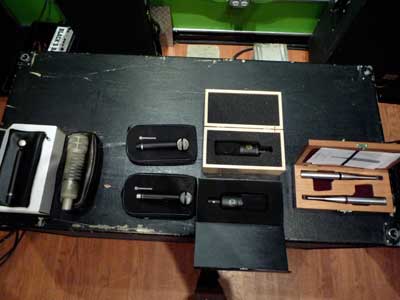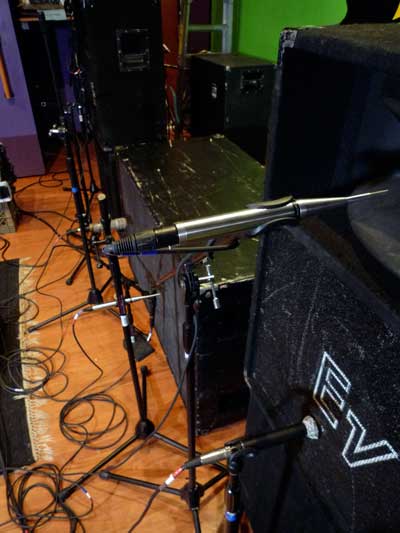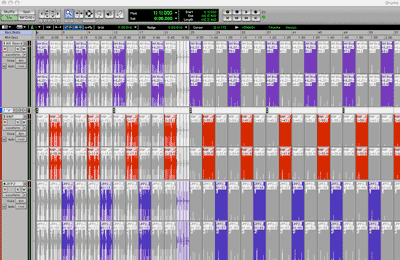|
04.07.09
EP Pre-production - Plan
&
Drum Machine, pt. I
So here's the plan:
We'll be running through all of the different choices we'll face by testing them out on one song that we've already recorded and released - Song 9, off of the "Where is my Robotic Boot?" compilation Hydra Head put out a little while ago. This song shares enough similarities with the stuff that we're doing for this EP that it will do nicely. The recording was done quickly in the basement and has lots of room for improvement.
"Song 9" - 2003 version, 160kbps.
Let's get started with the drums.
Element 1 - Drums, direct
When you listen to an instrument playing live in front of you, you're hearing more than just the sound waves traveling directly from that instrument to your ears. Whether it's a big or small room, how close you are to that instrument (and where it is in relation to your head), what other things are in the room with you, even something as esoteric as the humidity all affect what the final "sound" of how you experience that instrument.
All of these sounds other than the "direct" part of that sound are what we'll refer to as the "ambient" aspect of that instrument's sound. The blend between the direct and the ambient is a very, very important consideration we'll look at in all of the instruments we're recording for this thing. But, for the moment, we'll just want to look at the sound coming right out of the drum machine (which is why it says "drums, direct" above).
CHOICES
The drum machine does not produce enough gain (think of this as volume) coming directly out of its outputs to sound sufficiently good enough. In order to raise the volume, we looked at four options.
1. Mixing Board - Run the stereo outputs of the drum machine into two channels of the board, turn the gain up and go right out to the recorder.
2. Preamplifier, FMR RNP - Run the outputs into the Hi-Z inputs of each channel on the preamplifier, turn the gain up and go out to the recorder.
3. Preamplifier, Hamptone HJFP2 - Same as #2, but using the HJFP2.
4. Miking the PA - Run the drum machine out to the PA (as we do when playing live. Set up separate mics for the high and low drivers of each PA speaker, as well as one (centered mono) for the subwoofer. Select the best mics and preamplifiers, record each onto a separate track and mix together for the right level of sounds.
RESULTS
While sufficiently complicated, I'm happy to report that option 4 sounded easily the worst of the four and so was scrapped within about 2 minutes of comparison vs. the other three. (This despite the fact that I took two nights to pull all of the mic and preamp combinations together).
The three are compared in the clip below. The order here is 1, 2, 3, 1, 2, 3 ... with two measures each. To help guide the action, I say "one" every other time that the mixing board part comes back up. This is a 196 kbps MP3, which should be enough to get through the relevant details. The differences here are subtle and may not come through on laptop speakers.
Drum machine - direct, 3-way comparison.
To my ears the mixing board doesn't sound as good as the other two - it seems to lack detail, especially once the hi-hats come in. In comparing the preamps, I go back and forth. The RNP seems a bit cleaner than the HJFP2, while still having the deepest part of the low end. On the other hand, the HJFP2 has a very full sounding bottom part. I was worried, given its (intentional) tendency to give an overdriven (distorted) sound when the gain on it is cranked high, that it would fuzz out the details of the cymbals. But it has no problem clearly showing all of the important high parts.
DECISION AND NEXT STEPS
I am really on the fence about these two and need to listen for a day or so. I'm leaning toward the HJFP2 just because the low end is comparatively pronounced; I feel like I've shied away from putting real serious LF sounds on tape in the past. Although both are fine, the decision will also be affected by what preamp we use to record the ambient drum sound the next thing I'll work on. So, in other words: either.
|
|  |
 |
 |


It's a mic-off! This was a scintillating way to spend a late Saturday. You should have been there because it was awesome.

Justin's ill-conceived attempt to maybe test out different ways to mic amps instead of plugging the drum machine in directly. Not to spoil any surprises, but it didn't really work.

Screenshot of how the sound clip works. If this kind of thing looks familiar to you, you'll see how two tracks are always muted while the third is live.

|
 |
 |
 |
[ LATEST UPDATE ]
[ Archives ]
CONSTRUCTION
[ Overview ]
[ Basic Construction ]
[ Acoustics ]
[ HVAC ]
[ Electrical ]
[ The Grand Vision ]
[ Tool Reviews ]
[ Links and Resources ]
|